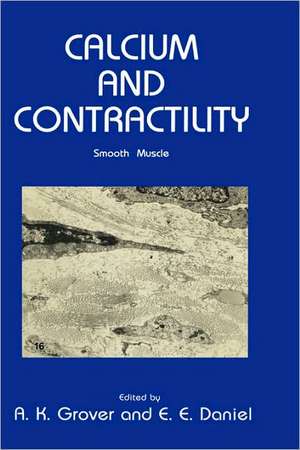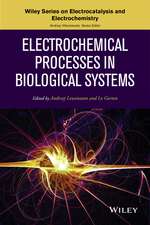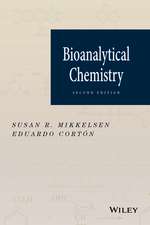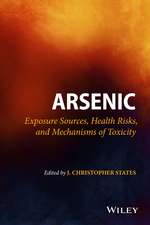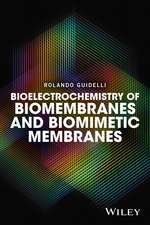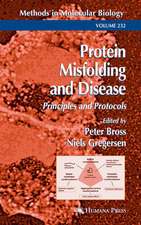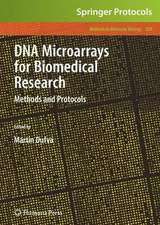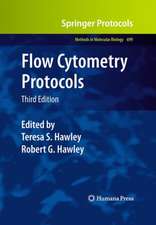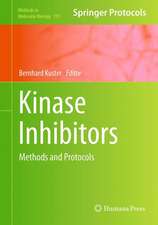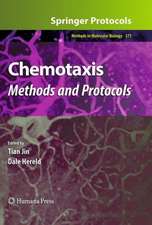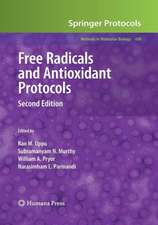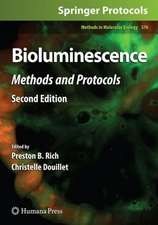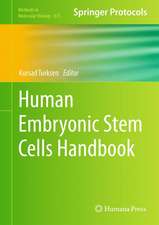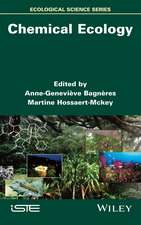Calcium and Contractility: Smooth Muscle: Contemporary Biomedicine, cartea 5
Editat de A. K. Grover, E. E. Danielsen Limba Engleză Hardback – 18 apr 1985
| Toate formatele și edițiile | Preț | Express |
|---|---|---|
| Paperback (1) | 948.12 lei 6-8 săpt. | |
| Humana Press Inc. – 7 oct 2011 | 948.12 lei 6-8 săpt. | |
| Hardback (1) | 960.93 lei 6-8 săpt. | |
| Humana Press Inc. – 18 apr 1985 | 960.93 lei 6-8 săpt. |
Din seria Contemporary Biomedicine
- 5%
 Preț: 1103.03 lei
Preț: 1103.03 lei - 5%
 Preț: 1432.02 lei
Preț: 1432.02 lei - 15%
 Preț: 656.74 lei
Preț: 656.74 lei - 5%
 Preț: 1120.40 lei
Preț: 1120.40 lei - 5%
 Preț: 1427.98 lei
Preț: 1427.98 lei - 5%
 Preț: 1299.43 lei
Preț: 1299.43 lei - 5%
 Preț: 1436.77 lei
Preț: 1436.77 lei - 5%
 Preț: 1436.00 lei
Preț: 1436.00 lei - 5%
 Preț: 731.43 lei
Preț: 731.43 lei - 5%
 Preț: 1432.17 lei
Preț: 1432.17 lei - 5%
 Preț: 719.02 lei
Preț: 719.02 lei - 5%
 Preț: 731.07 lei
Preț: 731.07 lei - 18%
 Preț: 1241.73 lei
Preț: 1241.73 lei - 5%
 Preț: 725.42 lei
Preț: 725.42 lei - 5%
 Preț: 733.09 lei
Preț: 733.09 lei - 8%
 Preț: 502.64 lei
Preț: 502.64 lei - 8%
 Preț: 536.52 lei
Preț: 536.52 lei -
 Preț: 455.69 lei
Preț: 455.69 lei -
 Preț: 394.22 lei
Preț: 394.22 lei - 8%
 Preț: 538.91 lei
Preț: 538.91 lei
Preț: 960.93 lei
Preț vechi: 1171.86 lei
-18% Nou
Puncte Express: 1441
Preț estimativ în valută:
183.93€ • 199.86$ • 154.60£
183.93€ • 199.86$ • 154.60£
Carte tipărită la comandă
Livrare economică 21 aprilie-05 mai
Preluare comenzi: 021 569.72.76
Specificații
ISBN-13: 9780896030664
ISBN-10: 0896030660
Pagini: 488
Ilustrații: XX, 488 p.
Dimensiuni: 155 x 235 x 29 mm
Greutate: 0.89 kg
Ediția:1985
Editura: Humana Press Inc.
Colecția Humana
Seria Contemporary Biomedicine
Locul publicării:Totowa, NJ, United States
ISBN-10: 0896030660
Pagini: 488
Ilustrații: XX, 488 p.
Dimensiuni: 155 x 235 x 29 mm
Greutate: 0.89 kg
Ediția:1985
Editura: Humana Press Inc.
Colecția Humana
Seria Contemporary Biomedicine
Locul publicării:Totowa, NJ, United States
Public țintă
ResearchCuprins
1 Structure of Smooth Muscle.- 1. Introduction.- 2. Organization and Arrangement of Smooth Muscle.- 2.1. Organization of the Uterus and Arrangement of the Myometrium.- 3. Morphology of the Smooth Muscle Cell.- 3.1. Size and Shape of Smooth Muscle Cells.- 3.2. Plasma Membrane.- 3.3. Sarcoplasmic Reticulum.- 3.4. Mitochondria and Other Organelles.- 3.5. Myofilaments.- 4. Innervation of Smooth Muscle.- 4.1. Innervation of the Myometrium.- 5. Structure of Cultured Cells.- 6. Localization of Ca2+ in Smooth Muscle.- 6.1. Precipitating Agents, Dyes, and Autoradiography.- 6.2. Electron Probe and Electron Energy Loss Analysis of Smooth Muscle.- References.- 2 Calcium Antagonists and Ionophores.- 1. Introduction.- 2. Calcium Channel Antagonists.- 2.1. Pharmacology.- 2.2. Structure—Activity Relationships.- 2.3. Sites of Action.- 3. Calcium lonophores.- 4. Summary.- References.- 3 Calcium Compartments and Mobilization During Contraction of Smooth Muscle.- 1. Introduction.- 2. Calcium Entry.- 2.1. Intrinsic Ca2+ Leak.- 2.2. Ca2+ Entry Stimulated by Membrane Depolarization.- 2.3. Receptor-Stimulated Ca2+ Entry.- 2.4. Role of Surface Bound Ca2+.- 3. Release of Intracellularly Bound Ca2+.- 3.1. Agonist-Induced Release of Cai.- 3.2. Caffeine-Induced Release of Cai.- 3.3. Ca2+-Induced Release of Cai.- 4. Modulation of Intracellular Ca2+ Sequestration.- 4.1. Ca2+ Sequestration During Relaxation.- 4.2. Agonist-Induced Alterations in Intracellular Ca2+ Sequestration.- 5. Summary.- References.- 4 Mechanisms of Smooth Muscle Relaxation.- 1. Introduction.- 2. Relaxation Mediated by Direct and Indirect Actions on Smooth Muscle.- 2.1. Actions at the Cell Membrane.- 2.2. Intracellular Actions.- 2.3. Involvement of Endothelium in Relaxation of Vascular Tissue.- 3. Mechanisms of Relaxation.- 3.1.Relaxation Through Interaction with Cyclic Nucleotides.- 3.2. Relaxation by Interaction with Calmodulin Entry.- 3.3. Relaxation Through Blockade of Calcium Entry.- 4. Concluding Remarks.- References.- 5 Smooth Muscle Relaxants.- 1. Introduction.- 2. Beta-Adrenoceptor Agonists.- 2.1. Isoproterenol.- 2.2. Selective Beta2-Adrenoceptor Agonists.- 3. The Xanthines.- 3.1. Pharmacological Actions.- 3.2. Pharmacokinetics.- 3.3. Toxicities and Side Effects.- 3.4. Therapeutic Uses.- 4. Alpha-Adrenoceptor Antagonists.- 4.1. Prazosin.- 5. Calcium-Channel Antagonists.- 5.1. Verapamil.- 5.2. Nifedipine.- 5.3. Diltiazem.- 5.4. Perhexiline.- 6. Nonspecific Vasodilators.- 6.1. Organic Nitrates and Nitrites.- 6.2. Hydralazine.- 6.3. Diazoxide.- 6.4. Sodium Nitroprusside.- 6.5. Minoxidil.- References.- 6 Cell-to-Cell Communication in Smooth Muscle.- 1. Introduction.- 2. Cell-to-Cell Junctions.- 2.1. Structural Studies.- 2.2. Methods for Quantification of Gap Junctions.- 2.3. Functional Studies of Gap Junctions.- 2.4. Regulation of Gap Junctions.- 3. Myometrial Gap Junctions.- 3.1. Presence of Myometrial Gap Junctions.- 3.2. Function of Myometrial Gap Junctions.- 3.3. Regulation of Gap Junctions in the Myometrium.- 4. Summary.- References.- 7 Calcium Regulation of Smooth Muscle Actomyosin.- 1. Introduction.- 2. Components of the Contractile Apparatus.- 2.1. Thick Filament.- 2.2. Thin Filament.- 3. Proteins Involved in the Phosphorylation and Dephosphorylation of Myosin.- 4. Effect of Phosphorylation of Myosin Light-Chain on the Properties of Myosin.- 4.1. Functional Changes.- 4.2. Structural Changes.- 5. Effect of Tropomyosin on the Actin-Activated ATP Hydrolysis.- 6. Direct Effect of Mg2+ and Ca2+ on Actin-Activation of Phosphorylated Myosin.- 7. Evidence for the Actin-Linked System in the Regulation of Actomyosin ATPase.- 8. Summary.- References.- 8 Studies on Skinned Fiber Preparations.- 1. Introduction.- 2. Methodology.- 2.1. Skinning Procedures.- 2.2. Criteria for Acceptable Models.- 3. Intracellular Ca2+ Store.- 4. Control of Actomyosin Interaction.- 4.1. Mechanism of Ca2+ Activation.- 4.2. Cyclic Nucleotides in Smooth Muscle Relaxation.- 4.3. Catch Mechanism.- 5. Effect of Ca2+ on Mechanical and Mechanochemical Properties of Smooth Muscle.- References.- 9 Smooth Muscle Subcellular Fractionation.- 1. Introduction.- 2. Homogenization Technique.- 2.1. Potter Elvehjem Homogenizer.- 2.2. Duall Tissue Grinder.- 2.3. Dounce Tissue Grinder.- 2.4. Potter-Elvehjem All-Glass Homogenizer.- 2.5. Disintegrinder.- 2.6. Sorvall and Omni Mixer Homogenizer.- 2.7. Willem’s Polytron Apparatus.- 2.8. Pressure Homogenization.- 3. Detailed Technique for Homogenization of Smooth Muscle.- 3.1. Rat Myometrium.- 3.2. Vascular Smooth Muscle.- 3.3. Vas Deferens Smooth Muscle.- 3.4. Dog Trachealis.- 3.5. Intestinal Smooth Muscle.- 4. Fractionation Techniques.- 4.1. Differential Centrifugation.- 4.2. Density Gradient Centrifugation.- 4.3. Zonal Ultracentrifugation.- 4.4. Continuous Sample Flow Density Gradient.- 4.5. Free-Flow Electrophoresis.- 4.6. Salt Extraction Method.- 4.7. Toluene—Lithium Bromide Method.- 5. Isolation of Various Subcellular Components.- 5.1. Cellular Components.- 5.2. Detailed Techniques Commonly in Use for Smooth Muscle Fractionation.- 6. Characterization of Subcellular Components.- 6.1. Morphology.- 6.2. Enzymatic Markers.- 6.3. Chemical Composition.- 6.4. Miscellaneous Markers.- 7. Special Studies.- 7.1. Membrane Orientation.- 7.2. Membrane Solubilization.- 7.3. Electrophoresis.- 7.4. Labeling Techniques.- 7.5. Labeling of Smooth Muscle CellSurface Proteins.- 8. Conclusion.- References.- 10 Calcium-Handling Studies Using Isolated Smooth Muscle Membranes.- 1. Introduction.- 2. ATP-Dependent Ca2+ Transport.- 2.1. Subcellular Distribution.- 2.2. Substrate Dependence.- 2.3. Evidence for Active Transport.- 2.4. Mechanism.- 2.5. Modulation.- 3. Na+—Ca2+ Exchange.- 4. Passive Ca2+ Binding.- 5. Ca2+ Release.- 6. Summary and Synthesis.- References.- 11 Receptor Binding Studies on Smooth Muscle Subcellular Fractions.- 1. Introduction.- 2. Significance of Receptor Binding Studies to the Understanding of Smooth Muscle Function.- 3. Limitations of Receptor Binding Studies.- 4. Studies of Specific Receptor Systems in Smooth Muscle.- 4.1. The Muscarinic Cholinoceptor.- 4.2. The Alpha-Adrenoceptor.- 4.3. The Beta-Adrenoceptor.- 4.4. Peptide Receptors.- 4.5. Receptors for Prostanoids.- 5. Future Directions for Receptor Binding Studies in Smooth Muscle Subcellular Fractions.- References.- 12 Calcium-Handling Defects and Smooth Muscle Pathophysiology.- 1. Introduction.- 2. Alterations of Vascular Smooth Muscles in Hypertension.- 2.1. Structural and Functional Changes.- 2.2. Contraction and Relaxation.- 2.3. Calcium Content and Fluxes.- 2.4. Calcium Accumulation by Isolated Membranes.- 3. Alterations of Nonvascular Smooth Muscles in Genetic Hypertension.- 3.1. Contractility.- 3.2. Calcium Handling by Isolated Membranes.- 4. Ionic Dysfunction as a Generalized Cell Membrane Alteration in Genetic Hypertension.- 4.1. Dysfunction of Calcium Metabolism.- 4.2. Dysfunction of Sodium Metabolism.- 4.3. Calcium, Sodium, and Hypertension.- 5. Conclusion and Comments.- References.- 13 Adrenergic Interactions in Smooth Muscle Contactility.- 1. Introduction.- 2. Classification of Receptor Types: Development of Current Concepts.- 2.1.?-and ?-Adrenoceptors.- 2.2. ?-Adrenoceptor Subtypes.- 2.3. Presynaptic Adrenoceptors.- 2.4. Postjunctional ?2-Adrenoceptors.- 2.5. Intrasynaptic ?-and -?-Adrenoceptors.- 3. The Andrenergic Neuron.- 4. Indirect Actions of Adrenoceptor Agonists and Antagonisis.- 4.1. Role of ?-Adrenoceptors in a Negative Feedback Mechanism.- 4.2. Role of ?-Receptors in a Positive Feedback Mechanism.- 5. Direct Actions of Adrenergic Drugs.- 5.1. Excitatory ?-Adrenoceptors.- 5.2. Inhibitory ?-Adrenoceptors.- 5.3. Inhibitory ?-Adrenoceptors.- 5.4. Summary.- 6. Conclusions and Future Directions for Research.- References.- 14 Cholinergic Interactions and Vascular Smooth Muscle Tone.- 1. Introduction.- 2. Acetylcholine-Induced Vasodilation Depends on Endothelial Cells.- 3. Direct Effect of Acetylcholine on Vascular Smooth Muscle.- 4. Calcium and Endothelium-Mediated Relaxation.- 5. Calcium and Vascular Smooth Muscle Contraction.- 6. Acetylcholine and Adrenergic Neuron Interaction.- 6.1. Peripheral Blood Vessels.- 6.2. Cerebral Blood Vessels.- 7. Calcium and Muscarinic Presynaptic Inhibition of Transmitter Release.- 8. Muscarinic Receptors on Adrenergic Nerve, Smooth Muscle, and Endothelial Cells.- 9. Preferential Effects of Acetylcholine on Blood Vessel Wall.- 10. Cholinergic Innervation and Acetylcholine.- 11. Is Acetylcholine the Vasoconstrictor or Vasodilator Transmitter?.- 12. Can Nerve-Released Acetylcholine Induce Vasodilation by Releasing Dilator Substance(s) from the Endothelial Cells?.- 13. Acetylcholine-Induced Membrane Hyperpolarization and Vasoconstriction.- 14. Conclusion.- References.- 15 Nonadrenergic, Noncholinergic (NANC) Neuronal Inhibitory Interactions with Smooth Muscle.- 1. Introduction.- 1.1. Criteria for Identification of NANC Mediators.- 1.2. Distribution ofNANC Nerves and Smooth Muscle Responses.- 2. Existence of Intrinsic NANC Inhibitory Neurons in Gut and Elsewhere.- 2.1. Gut.- 2.2. Airways.- 2.3. Blood Vessels.- 3. Identity of NANC Inhibitory Transmitters.- 3.1. Presence of ATP or VIP in NANC Fibers.- 3.2. Release of ATP and VIP by Nerve Stimulation.- 3.3. Identity of Action of ATP or VIP with Inhibitory Mediator.- 3.4. Identity of Inhibition and Potentiation of Responses to NANC Inhibitory Mediator and to ATP or VIP.- 3.5. Nature of NANC Transmitter for Dilation of Blood Vessels.- 3.6. Difficulties in Identifying NANC Transmitters and Role of Interstitial Cells of Cajal.- 4. Conclusions.- References.- 16 Nonadrenergic, Noncholinergic (NANC) Neuronal Excitatory Interactions with Smooth Muscle.- 1. Existence of NANC Excitatory Nerves in Gut and Elsewhere.- 1.1. Introduction.- 1.2. Gut.- 1.3. Urogenital Muscle.- 2. Identity of NANC Excitatory Transmitters.- 2.1. Role of Substance P in Gut.- 2.2. ATP as NANC Excitatory Cotransmitter in Urogenital Muscle.- 2.3. Possible NANC Excitatory Transmission in Blood Vessels.- 2.4. NANC Excitatory Transmitter at Other Smooth Muscles.- 3. Conclusion.- References.- 17 Peptide Calcium Interactions in Smooth Muscle.- 1. Introduction.- 2. The Gastrointestinal Tract.- 2.1. Gastrin—Cholycystokinin.- 2.2. Vasoactive Intestinal Polypeptide (VIP), Secretin, Glucagon/Glycentin, and Pancreatic Polypeptide.- 2.3. Neurotensin.- 2.4. Motilin.- 2.5. Substance P.- 2.6. Gastrin-Releasing Peptide/Bombesin.- 2.7. Other Peptides.- 3. The Urinary Bladder/Vas Deferens.- 4. The Respiratory Tract.- 5. The Vascular System.- 5.1. Bradykinin.- 5.2. The Neurohypophyseal Peptides, Oxytocin, and Vasopressin.- 5.3. Angiotensin.- 6. The Uterus.- 6.1. Angiotensin.- 6.2. Oxytocin.- 6.3. VIP.- 7. Conclusion.-References.
